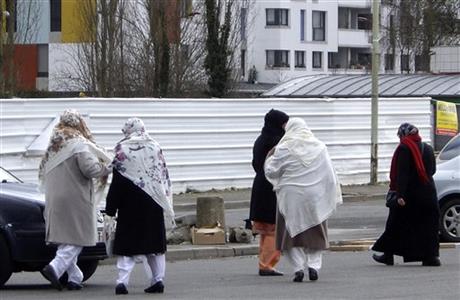
The French government launched a new effort Thursday to heal social and religious fractures by better teaching children about secular values and steering them away from extremist propaganda, after French-born Islamic radicals shocked the nation in three days of terrorist attacks.
Prime Minister Manuel Valls shocked many this week by referring to a “territorial, social, ethnic apartheid” that especially affects troubled suburbs or “banlieues,” tinderboxes of discontent where values that bind the nation are often absent. They house France’s poorest, especially minorities with immigrant roots, including many Muslims from former French colonies.
Valls convened a special government meeting Thursday to tackle this societal divide. The proposals that emerged focus on schools, which Valls calls an “essential link” in transmitting French values of tolerance and freedoms.
Concern about schools jumped to the forefront of national debate after some children refused to observe a minute of silence for victims of the Jan. 7-9 attacks on a kosher market and satirical newspaper Charlie Hebdo. Twenty people were killed, including the three gunmen, who had lived in restive neighborhoods in Paris and its suburbs.
In suburbs northeast of Paris on Thursday, many could understand why some children didn’t observe the moment of silence, even if they denounced the terrorist attacks.
“People were killed in the housing projects by police, and there was no minute of silence” for them, said Aly Sacko, a 28-year-old working with city hall in Clichy-sous-Bois. Two teenagers from immigrant backgrounds were killed in a power substation in Clichy-sous-Bois in 2005 while fleeing police, sparking weeks of riots in suburbs across the country. Similar incidents have prompted smaller riots in other cities in the decade since.
Sacko, a French-born Muslim of Malian origin, said the prime minister’s plans to fix poverty and social tensions are a “dream.” ”Nothing will change, I promise you,” he said.
The plans announced Thursday include special training and testing for school teachers about French and European citizenship, secularism and how to teach it.
Specific funds to help the poorest families with some schooling costs will increase by 20 percent, to 45 million euros ($52 million), she said.
Another idea is to teach children how to better navigate modern media, for example to distinguish between extremist propaganda and verified information. Every secondary school will be requested to develop its own radio, newspaper, or blog.
Education minister Najat Vallaud-Belkacem announced that the time dedicated to civics classes will increase from 100 to 300 hours during primary and secondary education.
The ideas remain vague, and relatively modest. And they are not France’s first effort to tackle troubles in the suburbs.
Unrest first broke out in 1990. Then-President Francois Mitterrand said the projects “provoke rejection, despair” and presciently called it a “problem which will weigh for years on our society.”
Violence continued to simmer. The big wake-up call came in 2005 with fiery nationwide riots. France seemed to discover only then that swaths of the population were living in a parallel world. Soaring unemployment, a high crime rate and even lack of access to public transport fed a deep sense of inequality.
The situation in the suburban housing projects defies France’s model for integration — assimilation by which all colors, races and creeds blend into a single people. It’s illegal to count people in France by ethnic or religious background, and diverse populations are expected to blend in — not live in ethnic enclaves.
Yet it is French officialdom that pushed newcomers into suburban projects, where today dozens of nationalities mostly cling to their roots.
When he was president, Nicolas Sarkozy made fixing the suburbs a priority. He created a Ministry of Immigration, Integration and National Identity — since dismantled — and in 2008 unveiled a master plan. It included $728 million to create new trains and tramways, an expansion of “second-chance schools” for dropouts, and professional guidance for thousands of youths wanting to start a company or get on a job track. It also included more police.
The plan grew and changed along the way. The global financial crisis hit, and Europe’s debt troubles, and attention turned elsewhere. There is no clear record of how assiduously it was enacted.
The housing project that was home to Amedy Coulibaly, one of the Paris gunmen this month, remains a different universe from the gilded governmental palaces of the capital, just a few miles (kilometers) away. Some doctors and postal workers refuse to venture into the Grande Borne in the town of Grigny. Even police enter with caution to a zone where drug dealers and teenage thugs hold sway.
Some improvements are visible in suburbs that received attention after the 2005 riots. In what was once one of the toughest projects in the Paris region, known as Les Bosquets (The Groves) in the town of Montfermeil northeast of Paris, high-rises and long buildings scarred with graffiti have been demolished, and replaced with human-sized town houses.
A police station has been installed in neighboring Clichy-Sous-Bois — where the 2005 riots got started. However, a long-promised tramway to reduce the approximately 90-minute journey by bus and train to nearby Paris and its job prospects hasn’t yet materialized, and may not be in place before 2019.
Samir Ouahfi, a 29-year-old father of three working in a cafe in Les Bosquets, had little hope that the current government would do better than its predecessors.
“They say there is equality and fraternity,” he said, referring to the French national motto. But here on the gray concrete of the projects, he added, “there isn’t any.”
___
Elaine Ganley reported from Montfermeil and Clichy-sous-Bois.



